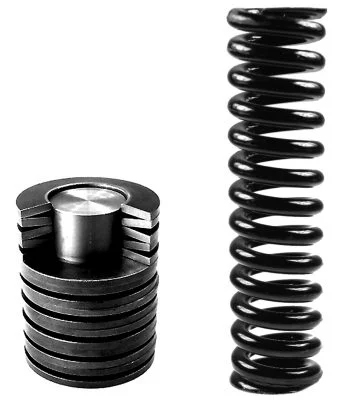A Belleville disc spring is a conical-shaped spring shaped like a washer.
Compared to a coiled spring, a Belleville spring is much smaller and can bear a much larger load relative to its deflection rate.
Coil springs and Belleville springs follow the same working principle as follows:
►The force is removed to release energy and return the spring back to its original position such as springs found on mattresses.
►When the spring is compressed, it produces potential energy such as those found on toasters.
►The force generated in the application is directly applied to the spring such as those that are used in a locking system.

A coil spring – also known as helical spring – is made of metal and can create energy when the coils are pushed together. It is made of an elastic material in a helix shape, which allows it to return to original form once the load has been lifted. This is commonly used in mattresses, toys, and shock absorber systems.
The following types of coil springs exist in the market:
►Torsion springs: These are designed to resist twisting actions often associated with clothes pegs.
►Volute springs: They are used for heavy load compression. The best example is the one found in M4 Sherman battle tanks.
►Compression coil spring: This type of spring is designed to resist compression. An example for this type of spring is found on car compression systems.
►Tension springs: These are designed to resist stretching.
Belleville disc springs function similarly as other springs but may only differ in terms of physical attributes. This kind of spring is flat and looks almost the same as a washer compared to the more traditional springs that we know of.
However, this is referred to as conical springs because when its center is raised or lifted, it creates a cone-shaped appearance. The shape created gives it the ability to support and carry heavy load.
To avoid the risk of having corroded springs, Belleville springs are coated. Since they are relied on to sustain great loads, they provide support in construction equipment or electrical transformers.
Belleville springs and coil springs may have the same function, but the basic difference is their load versus deflection characteristics. Belleville was designed to withstand very high loads with a small amount of deflection. Traditional coil springs can only accommodate lighter loads and much higher deflection.
The huge difference is in the application of these two types of springs because traditional coil springs may be used only for something as light as providing the clicking action of a mechanical pen. In contrast, Belleville springs are often used to give support to heavy loads such as metal machinery.
Knowing which type of spring to use—and in which combination—is a precise science. Our engineers can help you determine the best configurations and materials to meet your specific requirements.